

Why it's time to lay the selfish gene to rest – David Dobbs. A Neuroscientist's Radical Theory of How Networks Become Conscious - Wired Science. It’s a question that’s perplexed philosophers for centuries and scientists for decades: Where does consciousness come from?
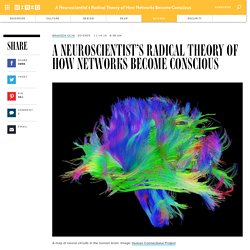
We know it exists, at least in ourselves. But how it arises from chemistry and electricity in our brains is an unsolved mystery. Neuroscientist Christof Koch, chief scientific officer at the Allen Institute for Brain Science, thinks he might know the answer. How to Build a Happier Brain - Julie Beck. There is a motif, in fiction and in life, of people having wonderful things happen to them, but still ending up unhappy.
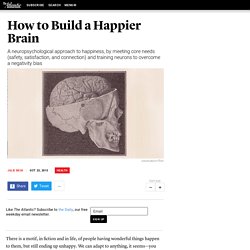
We can adapt to anything, it seems—you can get your dream job, marry a wonderful human, finally get 1 million dollars or Twitter followers—eventually we acclimate and find new things to complain about. If you want to look at it on a micro level, take an average day. You go to work; make some money; eat some food; interact with friends, family or co-workers; go home; and watch some TV. Nothing particularly bad happens, but you still can’t shake a feeling of stress, or worry, or inadequacy, or loneliness.
According to Dr. Kant's Critique of Pure Reason - Download free content from Oxford University. Social group may be key to fostering creativity. (Phys.org) —Creativity and genius are commonly seen as attributes of an individual, but new research indicates the role played by the surrounding group may be just as important.

Shared group membership, or lack of it, motivates individuals to rise to particular creative challenges, says Professor Alex Haslam from the School of Psychology at The University of Queensland. "Shared group membership provides a basis for certain forms of originality to be recognised, or disregarded," said Dr Haslam, who collaborated with international colleagues on a paper published recently in the Personality and Social Psychology Review.
Well-connected hemispheres of Einstein's brain may have sparked his brilliance. The left and right hemispheres of Albert Einstein's brain were unusually well connected to each other and may have contributed to his brilliance, according to a new study conducted in part by Florida State University evolutionary anthropologist Dean Falk.
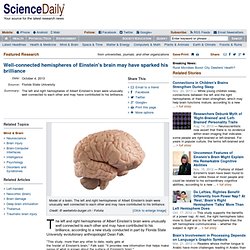
"This study, more than any other to date, really gets at the 'inside' of Einstein's brain," Falk said. "It provides new information that helps make sense of what is known about the surface of Einstein's brain. " The study, "The Corpus Callosum of Albert Einstein's Brain: Another Clue to His High Intelligence," was published in the journal Brain.
Lead author Weiwei Men of East China Normal University's Department of Physics developed a new technique to conduct the study, which is the first to detail Einstein's corpus callosum, the brain's largest bundle of fibers that connects the two cerebral hemispheres and facilitates interhemispheric communication. Evolution. [This critique has been withdrawn by the author.]

This point in the reasoning chain requires that different genes result in differing reproductive success and that those genes are passed on to offspring. Otherwise there isnt a reason to think that genetic mutation would result in accumulated differences. My impression here that randomized changes that dont result in variable reproductive success are eventually canceled out by other changes. Future species would have more variation in their genome, but wouldn't be any different, in other words the average genome would stay the same. Searle.pdf. Evolution of lying. Advances in Cultural Neuroscience. A lot of good stuff coming out around cultural neuroscience right now.
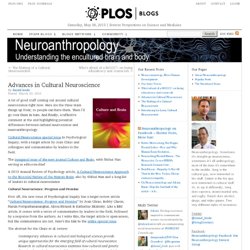
Here are the three main things up front, so people can have them. Then I’ll go over them in turn. And finally, a reflective comment at the end highlighting potential differences between cultural neuroscience and neuroanthropology. Cultural Neuroscience special issue in Psychological Inquiry, with a target article by Joan Chiao and colleagues and commentaries by leaders in the field. The inaugural issue of the new journal Culture and Brain , with Shihui Han serving as editor-in-chief A 2013 Annual Review of Psychology article, A Cultural Neuroscience Approach to the Biosocial Nature of the Human Brain , also by Shihui Han and a long-list of leaders in cultural neuroscience Cultural Neuroscience: Progress and Promise The abstract for the Chaio et al. review: Contemporary advances in cultural and biological sciences provide unique opportunities for the emerging field of cultural neuroscience. New journal Culture and Brain. Intelligent Robots Will Overtake Humans by 2100, Experts Say.
Are you prepared to meet your robot overlords?
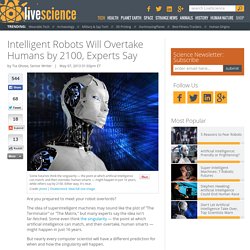
The idea of superintelligent machines may sound like the plot of "The Terminator" or "The Matrix," but many experts say the idea isn't far-fetched. Physicist Proposes New Way To Think About Intelligence. (ISNS) -- A single equation grounded in basic physics principles could describe intelligence and stimulate new insights in fields as diverse as finance and robotics, according to new research.
Alexander Wissner-Gross, a physicist at Harvard University and the Massachusetts Institute of Technology, and Cameron Freer, a mathematician at the University of Hawaii at Manoa, developed an equation that they say describes many intelligent or cognitive behaviors, such as upright walking and tool use. The researchers suggest that intelligent behavior stems from the impulse to seize control of future events in the environment. This is the exact opposite of the classic science-fiction scenario in which computers or robots become intelligent, then set their sights on taking over the world.
Home. IBM simulates 530 billion neurons, 100 trillion synapses on supercomputer. A network of neurosynaptic cores derived from long-distance wiring in the monkey brain: Neuro-synaptic cores are locally clustered into brain-inspired regions, and each core is represented as an individual point along the ring.

Arcs are drawn from a source core to a destination core with an edge color defined by the color assigned to the source core. (Credit: IBM) Announced in 2008, DARPA’s SyNAPSE program calls for developing electronic neuromorphic (brain-simulation) machine technology that scales to biological levels, using a cognitive computing architecture with 1010 neurons (10 billion) and 1014 synapses (100 trillion, based on estimates of the number of synapses in the human brain) to develop electronic neuromorphic machine technology that scales to biological levels.”
Simulating 10 billion neurons and 100 trillion synapses on most powerful supercomputer Neurosynaptic core (credit: IBM) Two billion neurosynaptic cores DARPA SyNAPSE Phase 0DARPA SyNAPSE Phase 1DARPA SyNAPSE Phase 2. 2013 IEEE Congress on Evolutionary Computation.